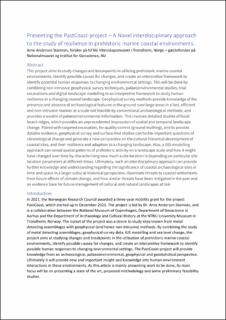| dc.description.abstract | This project aims to study changes and breakpoints in utilising prehistoric marine coastal environments, identify possible causes for changes, and create an interpretive framework to identify potential human responses to changing environmental settings. This will be done by combining non-intrusive geophysical survey techniques, palaeoenvironmental studies, trial excavations and digital landscape modelling in an interpretive framework to study human resilience in a changing coastal landscape. Geophysical survey methods provide knowledge of the presence and absence of archaeological features in the ground over large areas in a fast, efficient and non-intrusive manner at a scale not feasible by conventional archaeological methods, and provides a wealth of palaeoenvironmental information. This involves detailed studies of fossil beach ridges, which provides an unprecedented impression of spatial and temporal landscape change. Paired with targeted excavation, for quality control (ground-truthing), and to provide datable evidence, geophysical survey and surface-find studies can tackle important questions of chronological change and generate a new perspective on the cultural-historical development of coastal sites, and their resilience and adaption to a changing landscape. Also, a GIS-modelling approach can reveal spatial patterns of prehistoric activity on a landscape scale and how it might have changed over time by characterizing how much a site location is depending on particular site location parameters at different times. Ultimately, such an interdisciplinary approach can provide further knowledge and understanding regarding the significance of coastal archaeological sites in time and space in a larger cultural-historical perspective, illuminate threats to coastal settlements from future effects of climate change, and how similar threats have been mitigated in the past and an evidence base for future management of cultural and natural landscapes at risk. | en_US |
